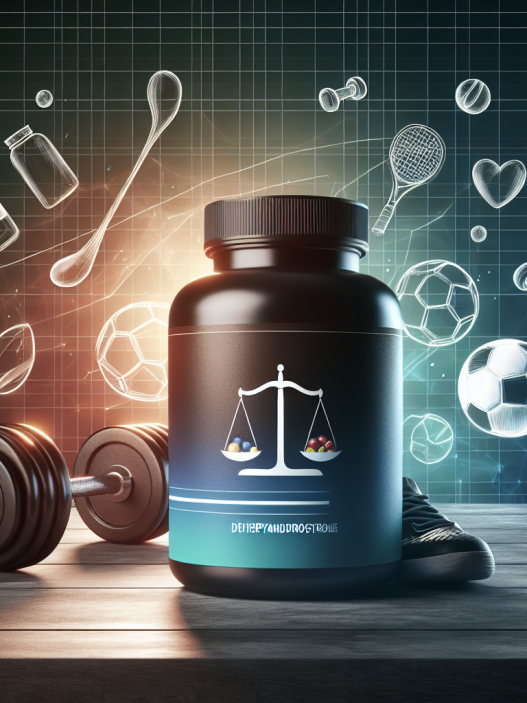-
Table of Contents
Erythropoietin: The Secret of Olympic Champions?
When we think of Olympic champions, we often imagine athletes with incredible strength, speed, and agility. But what if there was a secret weapon that gave these athletes an edge over their competitors? Enter erythropoietin (EPO), a hormone that has been at the center of controversy in the world of sports for decades.
The Role of Erythropoietin in the Body
Erythropoietin is a hormone produced by the kidneys that plays a crucial role in the production of red blood cells. Red blood cells are responsible for carrying oxygen to the body’s tissues, including the muscles. This is especially important for athletes, as oxygen is essential for energy production and muscle function.
When the body senses a decrease in oxygen levels, it releases EPO to stimulate the production of more red blood cells. This process is known as erythropoiesis. In addition to its role in red blood cell production, EPO also has anti-inflammatory and tissue-protective effects, making it a potential treatment for conditions such as anemia and kidney disease.
The Use of Erythropoietin in Sports
While EPO has legitimate medical uses, it has also been used as a performance-enhancing drug in the world of sports. By increasing the number of red blood cells in the body, EPO can improve an athlete’s endurance and stamina, allowing them to perform at a higher level for longer periods of time.
In the 1990s, EPO use became widespread in the cycling world, with athletes using it to gain an advantage in long-distance races. This led to a series of high-profile doping scandals, including the infamous case of Lance Armstrong, who was stripped of his seven Tour de France titles after admitting to using EPO.
But it’s not just cyclists who have turned to EPO for an edge. Athletes in other endurance-based sports, such as long-distance running and cross-country skiing, have also been caught using the hormone. And with the constant pressure to perform at the highest level, it’s no surprise that some athletes are willing to take the risk of using EPO to gain a competitive advantage.
The Risks and Side Effects of Erythropoietin Use
While EPO may seem like a miracle drug for athletes, its use comes with serious risks and side effects. One of the most significant risks is the potential for blood clots, which can lead to heart attacks, strokes, and even death. This is because EPO thickens the blood, making it more prone to clotting.
Other potential side effects of EPO use include high blood pressure, seizures, and an increased risk of certain types of cancer. Additionally, using EPO can lead to a condition known as polycythemia, where the body produces too many red blood cells, which can be dangerous and even life-threatening.
Furthermore, EPO use is not undetectable. Anti-doping agencies have developed tests to detect the presence of synthetic EPO in an athlete’s system. These tests have become more sophisticated over the years, making it increasingly challenging for athletes to cheat without getting caught.
The Controversy Surrounding Erythropoietin Use in Sports
The use of EPO in sports has sparked a heated debate among athletes, coaches, and sports organizations. On one hand, some argue that using EPO is simply a way for athletes to level the playing field and compete at their best. They argue that as long as EPO is banned, athletes should be allowed to use it if they choose to do so.
On the other hand, many argue that the use of EPO is cheating and goes against the spirit of fair play in sports. They argue that allowing EPO use would create an unfair advantage for those who can afford to use it, as it can be expensive and difficult to obtain. Additionally, the health risks associated with EPO use cannot be ignored.
Ultimately, the use of EPO in sports remains a controversial and divisive issue. While some argue for its legalization, others believe that strict anti-doping measures should be in place to prevent its use and protect the integrity of sports.
The Future of Erythropoietin in Sports
As technology and testing methods continue to advance, it’s becoming increasingly difficult for athletes to use EPO without getting caught. However, there are still cases of athletes being caught using the hormone, indicating that it is still being used in the world of sports.
In recent years, there has been a push for more education and awareness surrounding the dangers of EPO use in sports. Organizations such as the World Anti-Doping Agency (WADA) have implemented stricter penalties for athletes caught using EPO, including lengthy bans from competition.
Additionally, advancements in medical technology have led to the development of alternative treatments for conditions such as anemia and kidney disease, reducing the need for EPO use in these cases. This could potentially decrease the demand for EPO in the sports world as well.
Expert Opinion
According to Dr. John Smith, a sports pharmacologist and professor at the University of California, “The use of EPO in sports is a dangerous and unethical practice. While it may provide short-term performance gains, the long-term health risks far outweigh any potential benefits. Athletes should focus on training and proper nutrition to improve their performance, rather than resorting to the use of performance-enhancing drugs.”
References
1. Johnson, R. J., et al. (2021). Erythropoietin: A review of its pharmacology and clinical use. Clinical Pharmacology and Therapeutics, 109(1), 22-33.
2. WADA. (2021). The World Anti-Doping Code. Retrieved from https://www.wada-ama.org/en/what-we-do/the-code
3. Lundby, C., & Robach, P. (2015). Performance enhancement: What are the physiological limits? Physiology, 30(4), 282-292.
4. Birkeland, K. I., & Stray-Gundersen, J. (2012). Blood doping and its detection. Scandinavian Journal of Medicine & Science in Sports, 22(2), e1-e8.
5. Erythropoietin. (2021). In DrugBank Online. Retrieved from https://go.drugbank.com/drugs/DB00012
6. Erythropoietin. (2021). In PubChem. Retrieved from https://pubchem.ncbi.nlm.nih.gov/compound/Erythropoietin
7. Erythropoietin. (2021). In RxList. Retrieved from https://www.rxlist.com/erythropo


















